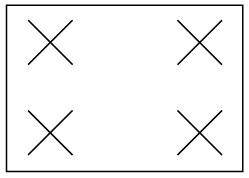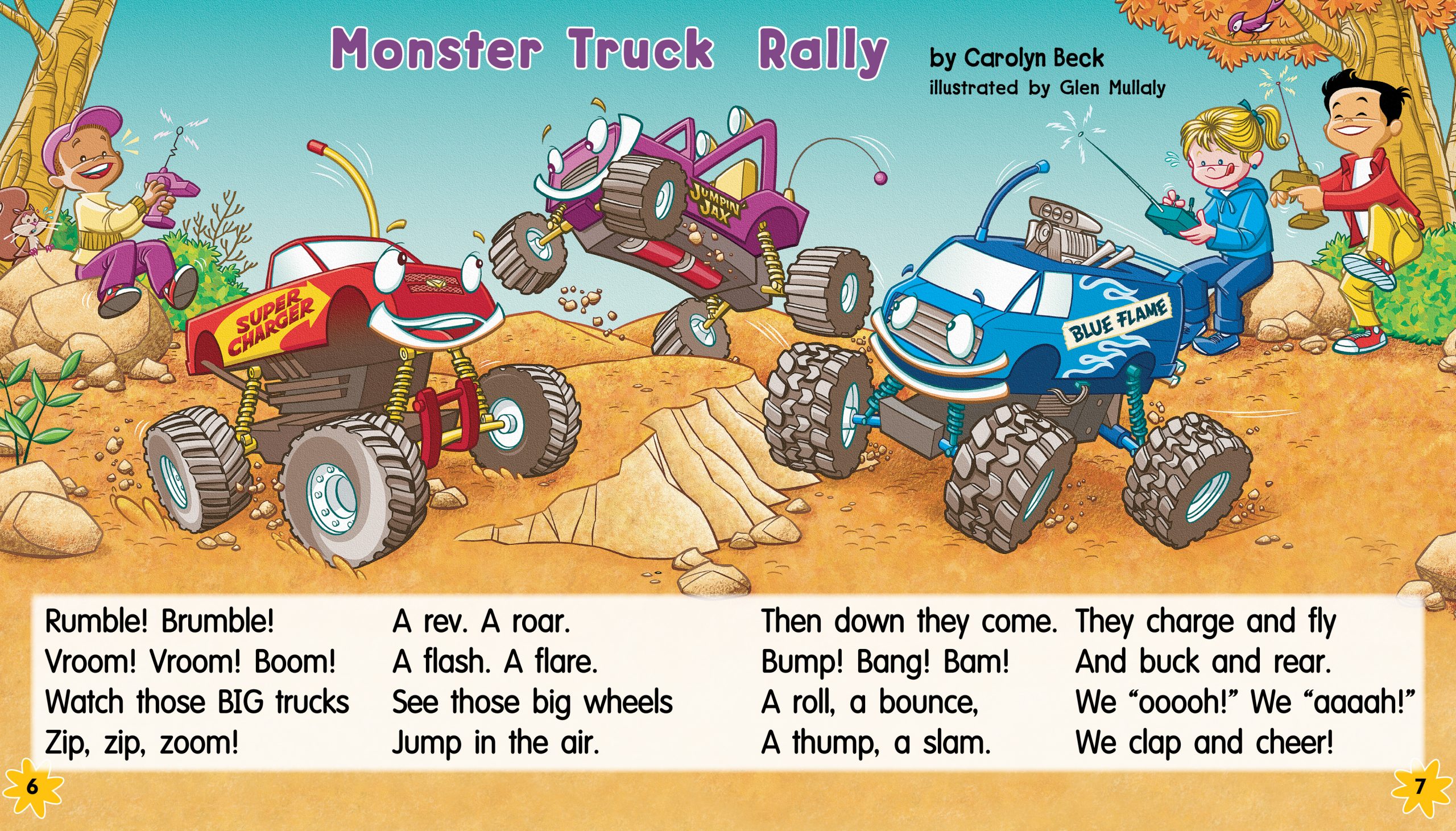Illustrated by Glen Mullaly
Text Type: Fiction: Poetry—rhyming song
Oral Language Teaching Strategy: Model Good Language Use Clarify and model good language use, without correcting, when individuals need support.
Time: 20–30 minutes
Materials:
– All Together Now, pages 6–7
– Media Key or Online: “Monster Truck Rally” audio
– boy and girl puppets
– one chair per student, arranged in 2 x 2 groupings
Grouping: whole class and partners
Assessment: Kindergarten Oral Language Assessement Scale. See especially the section on Phonological and Phonemic Awareness.
FIRST READING
BEFORE SINGING AND READING
Before students arrive, arrange classroom chairs in a 2 x 2 configuration (see diagram below). Each group of 4 chairs will be an imaginary monster truck.

Activating and Building Background Knowledge
- Ask students if they have ever seen a monster truck. Ask what makes it a ‘monster’? Invite students to discuss their ideas with an elbow partner and then ask some students to share their ideas with the group.
- Be sure to model appropriate language use, without correcting, when responding to and clarifying student ideas.
-
Today we’re going to use our imaginations and pretend that we’re all going for a drive in a monster truck.
Tell students that they’re going to pretend to drive a monster truck. -
Invite students to stand beside the chair that will be their seat in a monster truck. Demonstrate some or all of the following sounds and actions and ask students to copy you. Ask:
-
There are a lot of different sounds that we hear when we take a drive in a monster truck. Watch me and follow my actions. I’ll ask you to make a sound for each thing I do.
What sound does opening the truck door make? (scre-e-e-e-e-chy sound) - What sound does closing a door make? (slam sound, made by clapping hands)
- What sound does fastening a seat belt make? (click sound)
- What sound does turning on an engine make? (r-r-r-r-r-r-r sound)
- What sound does the engine make when it starts? (vroom sound)
- What does a truck sound like when it’s driving? (m-m-m-m-m-m sound)
- What sound is made when we turn a corner too fast? (e-e-e-e-e-e-e-e sound)
- What sound is made when we drive on a bumpy road? (tha-thump, tha-thump, tha-thump sound)
- What’s the sound of the windshield wipers? (ch-ch-ch-ch-ch or squeak-squeak-squeak sound)
- What’s the sound of the turning indicator? (tick-tock-tick-tock sound)
- What’s the sound when the truck stops? (silence)
-
-
When you got ready to make the sound “r-r-r-r,” is your mouth opened or closed? Where is your tongue? Get ready to make the sound and feel how your tongue, teeth and lips work together to make the sound.
To draw students’ attention to the initial sound of a word, teach them how to become aware of how our mouths ‘get ready’ to say a word. [Phonological awareness]
Setting a Purpose
-
Those sounds were great! Our monster truck sound really powerful. I have a new sound for you. It’s the song that plays on my monster truck’s radio.
Introduce the song “Monster Truck Rally” and explain to students that they should listen to the song and join in when they feel comfortable. Ask them to listen to find out what monster trucks can do. [Analyzing]
- Play the “Monster Truck Rally” song two or three times and allow students to respond naturally to the music.
DURING SINGING AND READING
-
Hi, my name is (name) and I was listening to your monster truck sounds. Wow, monster trucks really make a lot of noise! Now, I have a surprise for you.
Bring out a boy puppet and introduce him to the students. Use a different voice to speak as the boy.
-
I have a poem to read to you. Listen carefully and tell me what you notice.
Display the double-page illustration for “Monster Truck Rally.” Use the puppet to invite students to listen to the poem.
-
Have you heard the words in this poem before? Let’s listen to the song again and see if the words are the same.
Use the puppet to track the print as you read the poem to the class. After reading, use the puppet to ask students what they noticed about the poem. Then, if necessary, guide students to realize that the words of the poem are the same as the words of the song. test
- Model appropriate language and avoid correcting student responses (e.g., “We don’t say it like that, we say …”), so that students are encouraged to talk freely and without intimidation.
Dilshan: Noises… vroom!
Teacher: That’s right, the word ‘vroom’ was one of the noises in the monster truck song. - Use the puppet to track the words in the poem as the song is played again. Encourage students to sing along. [Phonological awareness]
- Focus on comprehension by offering prompts:
- What noises do the monster trucks make? Are these like any of the noises we made with our monster trucks? [Analyzing/making connections]
- How are the children in the illustration feeling as they play with the monster trucks? What makes you think that? [Inferring]
- Are the children driving the trucks? How are they making them work? (using remote controls) [Analyzing/inferring]
- Choose some of the noise words in the poem (e.g., ‘Vroom’) and discuss how your mouth gets ready for the first sound. [Phonological awareness]
Adding Playful Movements
- Play the song and encourage the students to ‘drive’ their imaginary trucks around the rooms as they sing the song.
AFTER SINGING AND READING
-
Monster trucks are big and strong. What can they do that regular trucks can’t do?
Revisit the purpose for singing and reading by asking students what types of things these monster trucks can do. [Analyzing]
SECOND AND FURTHER READING
The students will want to reread and re-sing “Monster Truck Rally.” During further lessons, consider including a balance of ideas from the following areas.
Engaging in Playful Language Activities
- Together with students, decide on a topic for a new song about a different kind of vehicle or something else that is noisy. Brainstorm noise and action words and write them out using the same pattern as the poem. Sing the words together along with the music-only song track.
- Together with students, look for action words in the song (‘zip,’ ‘zoom,’ ‘jump,’ ‘come,’ ‘bump,’ ‘bang,’ ‘roll,’ ‘bounce,’ ‘slam,’ ‘charge,’ ‘fly,’ ‘buck,’ ‘rear,’ ‘clap,’ ‘cheer’). Discuss the meanings of the words, then have students suggest actions to perform for each word. Practise reading the poem slowly, having students perform the actions along with each word.
Extending Comprehension
-
Remember when we were pretending to drive in our own monster trucks? Let’s use our imagination to describe what our trucks looked like. Elisha, what can you tell us about your monster truck?
Ask students to visualize and describe their own monster trucks. Use students’ descriptions to help draw comparisons between their different imagined monster trucks.
- Encourage each student to paint a word picture of their monster truck for an elbow partner by using as many describing words as
possible. Give several students the opportunity to
describe their monster trucks to the whole group.
-
Let’s look at the monster trucks in the illustration. What’s the same as the monster truck you imagined? What’s different from your monster truck?
Revisiting the illustration accompanying “Monster Truck Rally,” invite students to compare their imagined monster trucks with those shown in the illustration.
- Display the digital cloze version of the text on the Media Key. Working with the whole class, or with a small group, reread together and encourage students to supply the missing words (spaces for words highlighted in yellow). You may decide to pause to consider word predictions and prompt, “Does that make sense?” or “Does that sound right?” Then click on the colour-highlighted spot to reveal the word, saying, “Let’s check that out.” An option on the tool bar allows you to create your own cloze versions of the text to meet the needs of the students you are working with. Click on the ‘Help’ button to find out how to use the different features of the digital texts.
Developing Phonological Awareness
- Use percussion instruments (e.g., drums, tambourines, sticks, rattles) to beat out the rhythm of the music as you listen to the song.
- Ask students to clap the syllables in the two-syllable words ‘Monster,’ ‘Rally,’ ‘Rumble,’ and ‘Brumble.’
Enriching Print Concepts
-
My sister is here and I think she would love this poem. Could you help her read along with us?
Invite students to help another puppet (e.g., a girl puppet) to read the poem and sing the song. Use the boy puppet used earlier to introduce the new puppet.
- Students take turns being the girl puppet and tracking the words to the poem with the puppet while the whole class reads the poem together. Alternate between reading the poem and singing the song.
- Create a ‘Noisy Class’ chart. List each student’s name along with a noise word that begins with the same first letter. For example:
- Booming Beth
- Tick-Tock Tom
- Swishing Sarah
- Rumbling Ronnie
- You may wish to call students by their “noisy names” at other points during the school day.
FOLLOW-UP IN CENTRES
- Students can sculpt or build their own monster trucks from clay, blocks, or boxes and other scrap material. Have students name their trucks and introduce them to the rest of the class.
- If school computers have recording software, students can observe the different sound waves created when they make loud truck sounds and quiet truck sounds. The sound waves can be used to illustrate the differences between ‘indoor voices’ and ‘outdoor voices.’
- Place the big book in the listening centre with a pointer to encourage word-matching practise as students listen to the fluent reading on the Media Key or online.
- Create a ‘Find It’ game by writing some key words of the song on sticky notes and placing them by the big book. Students match the word on the sticky note with the word in the poem, placing the sticky note overtop.

